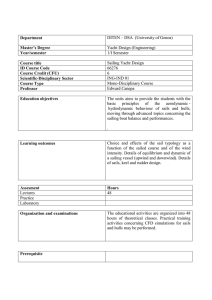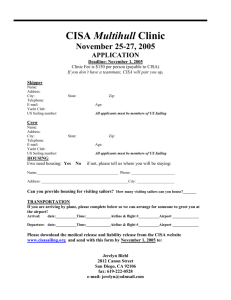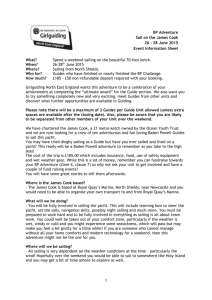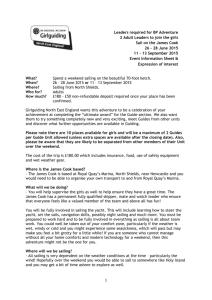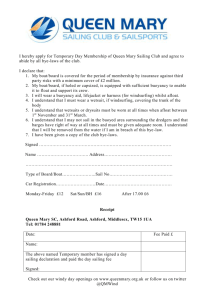Advisors
advertisement
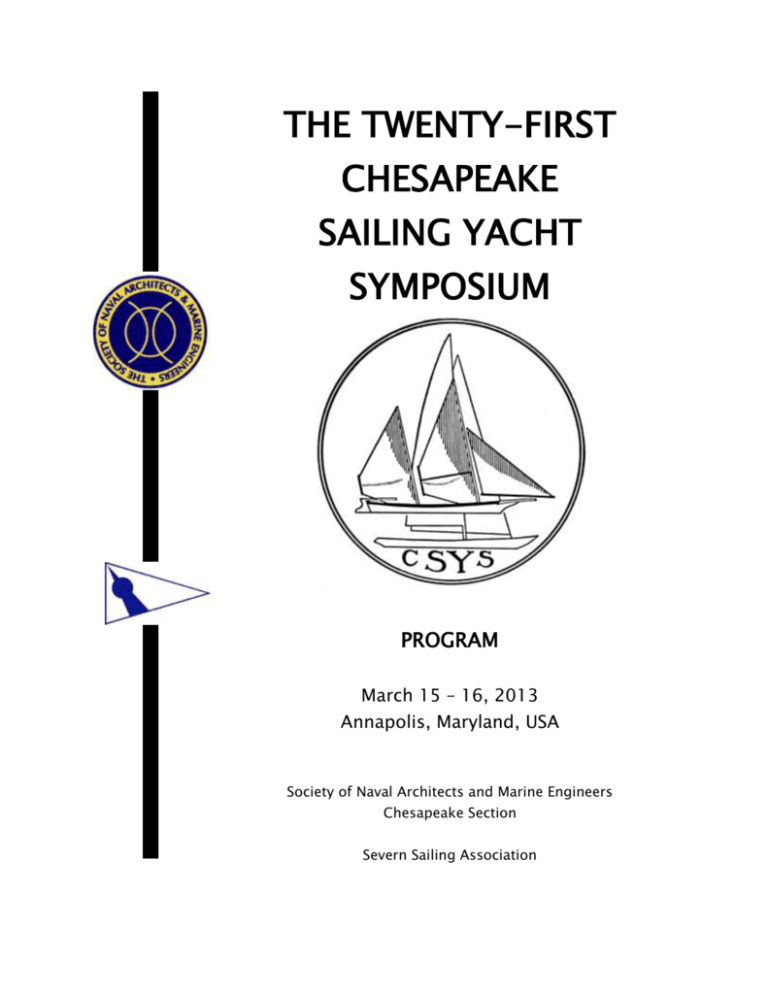
THE TWENTY-FIRST CHESAPEAKE SAILING YACHT SYMPOSIUM PROGRAM March 15 – 16, 2013 Annapolis, Maryland, USA Society of Naval Architects and Marine Engineers Chesapeake Section Severn Sailing Association The Twenty-First Chesapeake Sailing Yacht Symposium March 15-16, 2013 St. John’s College, Annapolis, MD Schedule Time DAY 1: Friday, March 15 2013 9:00 Registration Opens 10:00 Mustafa Insel, Ziya Saydam Investigation of Scale Effects in Sailing Yacht Performance Prediction by Experimental Methods 10:40 Katrina Legursky Least Squares Estimation of Sailing Yacht Dynamics from Full-Scale Sailing Data 11:20 Delft Systematic Yacht Hull Series Presentation 12:00 Lunch Break (On Own) 1:30 Peter Hinrichsen Bifilar Suspension Measurement of Keelboat Inertia Parameters 2:10 Ronan Douguet, Jean-Philippe Diguet, Johann Laurent, Yann Riou A New Real-time Method for Sailboat Performance estimation based on Leeway Modeling 2:50 Break 3:10 Robert Ranzenbach, Dave Armitage, Adolfo Carrau Mainsail Planform Optimization For IRC 52 Using Fluid Structure Interaction 3:50 Hannes Renzsch, Kai Graf An Experimental Validation Case For Fluid-Structure-Interaction Simulations Of Downwind Sails 4:30 ADJOURN The Twenty-First Chesapeake Sailing Yacht Symposium March 15-16, 2013 St. John’s College, Annapolis, MD Schedule Time DAY 2: Saturday, March 16 2013 8:00 Registration 9:00 Capt. Iver Franzen A Refinement of the Method Used to Determine the Balance of a Sailing Vessel During the Design Phase, with Application to Sail Design and Subsequent Sail Selection and Sailing Operations 9:40 Bruce Johnson, William Lasher, Matt Erdman, Jan Miles, Bill Curry Uncertainties In The Wind-Heel Analysis For Traditional Sailing Vessels: The Challenges It Presents For Forensic Analysis Of Sailing Vessel Incidents 10:20 Break 10:40 Stephen Duff, Fabio Fossati, Andy Claughton, Will Krzymowski, Tony Anderson The Evolution of Design: SALTS New Sail Training Schooner Project 11:20 Footy Regatta Presentation 12:00 Lunch Break (On Own) 1:30 ORC Presentation 2:10 Ignazio Maria Viola, Joshua Enlander On The Hydrodynamics Of A Skiff At Different Crew Positions 2:50 Break 3:10 Christoph Boehm, Robert Brehm, Janek Meyer, Lars Duggen, Kai Graf A Measurement System for Performance Monitoring on Small Sailing Dinghies 3:50 P.J. Richards, D.J. Le Pelley, D. Jowett, J. Little, O. Detlefsen A Wind Tunnel Study Of The Interaction Between Two Sailing Yachts 4:30 Britton Ward, Chris Cochran The Development of the New Volvo Class 5:30 Author’s Reception and Footy Regatta at the Cocktail Party Severn Sailing Association: 311 First Street, (410) 268-8744. The Twenty-First Chesapeake Sailing Yacht Symposium March 15-16, 2013 St. John’s College, Annapolis, MD Abstracts Investigation of Scale Effects in Sailing Yacht Performance Prediction by Experimental Methods, Mustafa Insel And Ziya Saydam A substantial amount of research has been carried out in the past to enhance the testing techniques and to increase the accuracy associated with tank testing of sailing yachts. The majority of this work was associated with high budgeted campaigns; large models, long waiting times and high budgets became standard practice in the field. This led to lack of accessibility for low budgeted campaigns and for designers of ordinary sailing yachts to these tests. A research study has been initiated to investigate the scale effects associated with tank testing of sailing yachts. The intention has been to make best use of modern experimental and computational methods to understand the scale effects in conjunction with systematic tank tests. Both viscous and wave components were considered for investigation of scale effects in sailing yacht performance prediction. Four different scale models ranging from 1/4 to 1/10 of a TP52 yacht have been tested in the towing tank in upright and heeled condition while full, half and quarter scale computational analysis have been carried out with a RANS code. The wave pattern measurements were conducted for all upright and heeled cases with the use of three wave probes on each side. Variation of drag, sideforce, running attitude and wave pattern have been investigated. This paper focuses on the experimental investigations both in the upright and heeled conditions. Least Squares Estimation of Sailing Yacht Dynamics from Full-Scale Sailing Data, Katrina Legursky Linear dynamic models are extremely useful in autonomous vehicle controller development because they are straightforward to estimate from real data and they enable advanced control system design. To date an in depth investigation of the possibility of using a linear dynamic system model to represent sailing yacht dynamics has not been made. A non-linear simulation of a 10m racer/cruiser racer and full-scale data collected aboard a 23 ft day-sailer are used in conjunction with the one-shot least squares estimation algorithm to evaluate this possibility. Using the non-linear simulation data it is found that it is possible to use a linear model to represent sailing yacht. Fullscale data collected while sailing upwind on a port tack is used to estimate 10 different linear models. The Twenty-First Chesapeake Sailing Yacht Symposium March 15-16, 2013 St. John’s College, Annapolis, MD Abstracts Bifilar Suspension Measurement of Keelboat Inertia Parameters, Peter Hinrichsen Measurements of the inertia parameters of a keelboat hull using a bifilar suspension are described. Bifilar yaw moment measurement normally entails accurate measurement of the length l and spacing 2d of the suspension, and of Ty the period of pure yaw oscillation1. The primary difficulty with a bifilar suspension is avoiding unwanted modes of oscillation, specifically sway when measuring yaw. However, for an athwartships suspension the sway motion is that of a simple pendulum of period Ts and observation of the combined motion allows the yaw gyradius to be determined as ky = (Ty/Ts)d. Thus only the ratio of the periods and the suspension spacing need be measured. Measurements of the normal mode periods of the double pendulum motion when the suspension is displaced in heave allows the height of the center of mass and the pitch gyradius k to be determined. Repeating yaw measurements with the hull tilted, and then with the bifilar suspension fore and aft to measure the roll gyradius kr, allow the angle Ψ _of the inertia ellipse principal x axis to the hull x axis to be calculated. A New Real-time Method for Sailboat Performance estimation based on Leeway Modeling, Ronan Douguet, Jean-Philippe Diguet, Johann Laurent, Yann Riou This paper presents new methods for real time estimation of leeway and ocean current, which are based on boat displacements. We propose two solutions that rely on several types of Kalman filters. The first one uses the empirical leeway definition and allows finding the key parameter of this formula. The solution works properly if the error of the formula of leeway remains limited. The second solution takes advantage of an additional sensor and we compare three methods to linearize boat displacements, which are based on a closed-loop model including cascaded filters. These methods are tested on simulation and on real data collected with a maxi multihull. The results first validate the use of a DVL sensor for leeway estimation but also show that it requires the implementation of a complex and specific step of signal processing. Secondly our study demonstrates the relevancy of the closed-loop approach and shows that a solution, based on UKF filters, provides a relevant method to cope with accuracy and stability in case of sensor data outage. The Twenty-First Chesapeake Sailing Yacht Symposium March 15-16, 2013 St. John’s College, Annapolis, MD Abstracts Mainsail Planform Optimization For IRC 52 Using Fluid Structure Interaction, Robert Ranzenbach, Dave Armitage and Adolfo Carrau Most IRC 52 based upon existing TP52 retain their original rig proportions and mainsail girths to avoid the cost and disruption of a rig change and to not disturb the finely tuned yaw balance. It is not obvious whether the mainsail proportions essentially dictated by the TP52 box rule (aggressively square topped mainsails) are actually optimal under IRC even though IRC 52 with TP52 style mainsails tend to successfully compete under IRC. To determine the answer to this question, a mainsail planform investigation was performed as collaboration between Botin Partners and Quantum Sail Design Group. The mainsail planform investigation utilized a Fluid Structure Interaction (FSI) program developed by Quantum Sail Design Group (QSDG) known as IQ Technology (IQT) that consists of sail geometry definition, inviscid Computational Fluid Dynamics (CFD), Finite Element Analysis (FEA), Velocity Prediction Program (VPP), and shape validation (based upon VSPARS) modules. Applicability of the inviscid CFD was validated by comparison to a limited number of viscous flow solutions, i.e. RANS analysis, performed by Porto Ricerca. Two mainsails were considered, a conventional TP52 style and an alternative that was chosen to be closer to the IRC default girth values. To maintain sail area and yaw balance, the alternative mainsail had a longer P and E. The focus of the study was exclusively on upwind performance, i.e. to maximize upwind Velocity Made Good (VMG). Results from the study suggest that a TP52 style mainsail is not optimal under IRC. The combination of rating reduction and predicted performance advantages over a wide range of wind speeds suggest that an alternative mainsail with larger P and E with girth values closer to the IRC default values is a superior choice for an IRC 52. An Experimental Validation Case For Fluid-Structure-Interaction Simulations Of Downwind Sails, H. Renzsch, K. Graf In this paper the results of wind tunnel tests on two different asymmetric spinnakers are presented. During these tests forces and flying shapes at different apparent wind angles and trims were recorded by 6DoF balance and photogrammetry. As these tests are intended as a validation benchmark for FSI-simulations on downwind sails, the sail moulds, incident flow data as well as measured forces and flying shapes will be made publically available. The Twenty-First Chesapeake Sailing Yacht Symposium March 15-16, 2013 St. John’s College, Annapolis, MD Abstracts A Refinement of the Method Used to Determine the Balance of a Sailing Vessel During the Design Phase, with Application to Sail Design and Subsequent Sail Selection and Sailing Operations, Capt. Iver Franzen The thrust of this paper is, first, to attempt to define the relationship between the individual sails, both together and separately, and the hull with somewhat more precision, and secondly, to develop a calculation tool to better establish this relationship, and to better anticipate the vessel's over all sailing behavior. Because of those factors that affect balance including and beyond those addressed by the traditional design approach as taught by most current texts on sailboat balance, the need for the factor "lead" will never go away. However, by including, as will be demonstrated, an additional balance factor, specifically the longitudinal sheet positions, into the balance equations during the design phase, sailboat balance can be predicted with better accuracy. The primary objective of this refinement will be the ability to design sail profiles, especially the complement of headsails, which will result in the least (adverse) change of balance when changing from one headsail to another, and which can be applied to either new designs, or to existing boats in need of out-of-balance remedies. This would mean that each anticipated sail combination can be analyzed for its lead, and therefore adjusted during the design phase to insure that proper helm is maintained from one combination to the next. Uncertainties In The Wind-Heel Analysis For Traditional Sailing Vessels: The Challenges It Presents For Forensic Analysis Of Sailing Vessel Incidents, Bruce Johnson, William Lasher, Matt Erdman, Jan Miles and Bill Curry There are many uncertainties in the interpretation of full-scale sailing vessel data taken under dynamic conditions, and even more uncertainties when forensic analysis is attempted based only on survivor’s recollections. Frequently, the analysis is based on static equilibrium assumptions, sometimes modified to steady-state motions of the wind and heeling response of the vessel. Dynamic conditions are generally non-deterministic and statistical methods must be used. Even more complicated is the non-stationary random process nature of most accidents. Examples of quasi steady-state response are presented in the paper as characterized by the Wind Heel Stiffness Ratio (WHSR), which is equal to the square of the apparent wind velocity in knots divided by the resulting heel angle in degrees. WHSR is not nondimensional but is independent of the system of units, (SI vs. EG). The WHSR for each The Twenty-First Chesapeake Sailing Yacht Symposium March 15-16, 2013 St. John’s College, Annapolis, MD sail combination is most easily established by a maneuver the crew of Pride II has deemed “The Crazy Ivan.” However, it is uncertain whether this concept can make useful predictions at heel angles higher than those beyond GZmax in the absence of any good data taken during these conditions. CFD studies of various sail combinations provide very good agreement between the recorded wind-heel responses of the vessel up to deck edge submergence. The corresponding CFD predictions provide a method of predicting the normal wind heel responses of a traditional sailing vessel during the design process. The paper discusses operational guidance uncertainties that appear as a “fork in the road” decision, with bearing away as one path and heading up as the other. The paper examines the tradeoffs in the decision making process relative to the type of vessel involved and the observable wind and sea conditions at the time. Recent attempts to reanalyze the dismasting of Pride II in 2005 and the sinking of the SV Concordia off Brazil in 2010 are also included. Lastly, the possible downward lift force involving square sails at high angles of heel needs to be investigated in wind tunnels since full scale testing of this concept is virtually impossible. The Evolution of Design: SALTS New Sail Training Schooner Project, Stephen Duff, Fabio Fossati, Andy Claughton, Will Krzymowski, Tony Anderson The Sail and Life Training Society is building a new purpose-designed 35m wooden sail-training schooner for unrestricted foreign-going operations. Working with an international team of consultants, SALTS has initiated an ambitious agenda of analytical and experimental investigations to support design, including a parametric study of hull form as it relates to stability at high angles of heel, the development of bespoke parametric design and analysis tools using the graphical algorithm editor Grasshopper, a towing tank campaign at the Wolfson Unit to investigate the behavior of three keel profiles, and a wind tunnel campaign at Politecnico di Milano to investigate the behavior of fifteen sail plans. Preliminary results from these studies will be presented, set in the context of the unfolding story of the evolution of the design of the new vessel. The Twenty-First Chesapeake Sailing Yacht Symposium March 15-16, 2013 St. John’s College, Annapolis, MD Abstracts On The Hydrodynamics Of A Skiff At Different Crew Positions, Ignazio Maria Viola And Joshua Enlander A set of towing tank tests was undertaken on a 1:4-model-scale high-performance small sailing boat, which was a candidate for the 2016 Olympic games. The resistance, sink and trim were measured and uncertainty analysis was completed. The boat was tested for different longitudinal positions of the crew in displacement, transition and fully planning regimes. The resistance measurements in the towing tank were well correlated with established empirical formulations developed for planning hulls. It was found that at low Froude numbers, forward crew positions allow lower resistance and resistance increases significantly for after crew positions, while at higher Froude numbers after positions allow lower resistance, and the resistance is less sensible to the crew position. These findings are in agreement with sailor experience and with measurements performed by other authors on large vessels. A Measurement System for Performance Monitoring on Small Sailing Dinghies, Christoph Boehm, Robert Brehm, Janek Meyer, Lars Duggen, Kai Graf This paper describes a new performance monitoring system for dinghies and small sailing boats, developed in a collaborative project of the Yacht Research Unit Kiel (YRUK) and the Mads Clausen Institute (MCI) of the University of Southern Denmark. The system under development features a complete set of nautical instruments (wind, boat speed and heading, position) as well as dynamic sensors measuring the motion of the dinghy with additional audio and video streams for crew observations. Most sensors are integrated in a small lightweight housing also containing a main processing unit to be mounted on a dinghy. Some external miniaturized sensors (wind and water anemometers) are connected wirelessly. Data and media streams are recorded. Further a telemetry system allows online data transmission to a remote client operated on a coach boat. Analysis software allows the coach to visualize and analyze the performance of the dinghy. Both, the hardware system and the analysis software are presented here including first results from a field trial. The Twenty-First Chesapeake Sailing Yacht Symposium March 15-16, 2013 St. John’s College, Annapolis, MD Abstracts A Wind Tunnel Study Of The Interaction Between Two Sailing Yachts, P.J. Richards, D.J. Le Pelley, D. Jowett, J. Little, and O. Detlefsen The interference between two yachts sailing in several conditions is investigated in the wind tunnel by using two similar yacht models, one of which is mounted on a force balance and the other moved around the test section. The yachts were configured to sail close-hauled upwind at 20° apparent wind angle, downwind under asymmetric spinnaker at 60° and downwind under symmetric spinnaker at 120° apparent wind angle. The regions of positive and negative interference are determined through aerodynamic force measurement and flow disturbance measurement, and the sources of these effects investigated. The Development of the New Volvo Class, Britton Ward and Chris Cochran For the 2014-15 Volvo Ocean Race, the organizing authority made a dramatic shift in direction for the next two editions of the race opting to move to a smaller, less expensive yacht built to exceptionally strict one design standards. This paper outlines some of the motivations for this shift and details some of the critical features of the new Volvo Ocean 65 design and how they compare to solutions on the previous Volvo Open 70 yachts. Discussion of the logistical complexities involved in building the fleet of boats in the required time is also discussed. A review of the structural design is included to illustrate the efforts to improve construction efficiency, reduce cost and dramatically improve robustness of the yacht structures while minimizing the weight additions that result. Finally we review some of the extensive quality control procedures and manufacturing technology that has been employed in an effort to achieve a fleet of one design yachts that are as identical as possible. The Twenty-First Chesapeake Sailing Yacht Symposium March 15-16, 2013 St. John’s College, Annapolis, MD Steering Committee Jaye Falls Greg Buley Aurore Zuzick Britton Ward Russell Miller Mat Bird General Chairman Papers Chairman Arrangements Publicity/ Registration Publicity Webmaster Advisors Bruce Johnson John Zseleczky Cocktail Party Direction and Transportation The cocktail party that concludes the symposium is located at the Severn Sailing Association (SSA), at 311 First Street, Annapolis MD 21403 (in the Eastport section of town). From St. John’s College, SSA is a 1.4 mile (2.2 km) walk. There is also street parking available on First Street, and there is some parking space available at SSA. New this year, symposium attendees at the cocktail party can call eCruisers for transportation from SSA to locations in downtown Annapolis. ECruisers operates electric, low-speed vechicles that transport people short distances. This service is without charge if you visit the eCruiser FaceBook page, http://www.facebook.com/eCruisers, and click “like” to retrieve the password of the week. There are two dispatch numbers to call for a ride: 443.481.2422 and 443.497.4769. A map of downtown Annapolis, including SSA, is on the following page. A walking path is highlighted between St. John’s College and the Severn Sailing Association. The Twenty-First Chesapeake Sailing Yacht Symposium March 15-16, 2013 St. John’s College, Annapolis, MD
